













Washington-St. Tammany Electric Cooperative is committed to safely providing reliable power Page 20











On this enchanting 9-day cruise from Charleston to Amelia Island, experience the charm and hospitality of the South. In the comfort of our modern fleet, travel to some of the most beautiful historic cities in America. The fascinating sites you visit, the warm people you meet, and the delectable cuisine you taste, come together for an unforgettable journey. Small Ship Cruising

























The new year ushers in a new president, a new Congress and new elected officials. It also provides electric cooperative members like YOU more opportunities to demonstrate our collective political strength.
Grassroots advocacy and political engagement are essential for a healthy democracy. From communicating directly with policymakers and signing petitions to posting on social media and attending town halls, there are many ways to ensure your voice is heard as lawmakers shape policies that affect your communities. When you are politically engaged, you are actively participating in the democratic process.
Political engagement starts with understanding which policies are important to your family, community and co-op and how those policies can affect your way of life. As a member of the Louisiana Electric Cooperatives, you know your communities best. This knowledge empowers you to make informed decisions—especially about candidates running for political office.
Elected officials work for us, and they want to hear from you. When you engage directly with a policymaker, you hold them accountable for their decisions. When you send emails and letters, attend town hall
meetings, or meet with policymakers or their staff, you are sharing your co-op story and reinforcing what matters to you and your family. Your voice matters. The electric co-op voice matters.

Political engagement helps tell the co-op story and educates policymakers on the value co-ops bring to local communities. It reinforces your co-op’s commitment to providing safe, reliable, affordable power. And it helps create valuable relationships built on trust and understanding.
How can you tell your co-op story?
Voices for Cooperative Power can help you become more politically engaged. VCP is a national network of more than 1 million Americans dedicated to transforming co-op communities like ours.
VCP members communicate with policymakers on the localized, communitybased approach electric co-ops take to keeping the lights on. We take a stand when policy decisions threaten our access to safe, reliable, affordable power.
CEO Addie Armato
SAFETY COORDINATOR Ricky Melancon
COMMUNICATIONS COORDINATOR Conley Bourgeois
MEMBER ENGAGEMENT COORDINATOR Rhianna Garon
ACCOUNTING MANAGER Beth Fraser
CREDIT UNION Jody Overhultz, representative
President Michael Heinen
Vice President Roger Dale DeHart
Secretary/Treasurer Richard Sitman



BEAUREGARD ELECTRIC COOPERATIVE INC.
Trent Buxton Mike Viator
CLAIBORNE ELECTRIC COOPERATIVE INC.
Mike Marcotte Lane Davidson
DEMCO
Daniel Berthelot Richard “Dickie” Sitman
JEFF DAVIS ELECTRIC COOPERATIVE INC.
Michael Heinen Byron Hardee
SOUTH LOUISIANA ELECTRIC COOP ASSOCIATION
Trevor Benoit Roger Dale DeHart
WASHINGTONST. TAMMANY ELECTRIC COOP INC.
Joe Jarrell Dennis Glass
Associate Member
PANOLAHARRISON ELECTRIC COOPERATIVE INC.

As job creators, economic drivers and, most importantly, community members, co-ops play a key role in the future of rural and suburban America. More than 42 million Americans rely on electric co-ops to power their homes, farms, businesses, industries and schools. VCP helps ensure these voices are heard.
When becoming a member of VCP, you receive regular updates on key issues that affect your electric cooperative and your community. As a member, you have opportunities to communicate with your policymakers on those key issues. VCP members also have access to voter resources, including guidance on how to be a co-op voter.
Are you a member of VCP? If not, now is the time to join. Tell your friends and family about VCP and encourage them to join. Share your co-op story. Be a co-op voter. Together, we will make a difference.


Use your smartphone’s camera to scan for a quick link to the VCP network today.


WASHINGTONST. TAMMANY ELECTRIC OFFICES
Main office
950 Pearl St. (P.O. Box 697)
Franklinton, LA 70438
Phone: 985-839-3562
www.wste.coop
Additional offices
21504 Mire Drive
Abita Springs, LA 70420
13526 Hwy. 40 Folsom, LA 70437
2081 E. Gause Blvd.
Slidell, LA 70459
GENERAL MANAGER
Dane Hocott
BOARD OF DIRECTORS
Dr. Francis Cefalu | President
Dennis Glass | Vice President
Olander Smith | Secretary
Glenn Magee | Treasurer
Joe Jarrell Jr.
Chris Graves
Billy Wayne Rester
Charles Singletary
Nickey Smith
Louisiana Country (USPS 473-180) is published bimonthly by the Association of Louisiana Electric Co-ops Inc., 10725 Airline Hwy., Baton Rouge, LA 70816, in partnership with Pioneer Utility Resources.
Annual subscriptions: Members $2.59. Nonmembers $5.
Postmaster: Send form 3579 to 10725 Airline Hwy., Baton Rouge, LA 70816.
Periodicals postage paid at Baton Rouge, Louisiana 70821, and additional mailing offices.
Safety is a priority at Washington-St. Tammany Electric Cooperative because electricity can be dangerous, even though it’s an essential part of our lives. We can enjoy all its benefits as long as we respect it.
We invest in our employees by using training programs from local, state, and national organizations to provide them with the skills they need to provide safe and reliable electric service to our members.
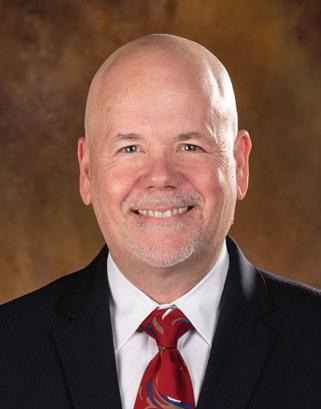
Last year, we participated in a national program called The Commitment to Zero Contacts 2.0, sponsored by the National Rural Electric Cooperative Association and our insurance company. This program was designed to improve the safety culture at electric cooperatives across the country.
In 2025, we continue to focus on safety and training for employees and community members as we strive to provide you with the world-class service you want and deserve. We are exploring new technologies that help us improve our system and outage response programs.
It’s important to remember the dangers of downed power lines and other safety hazards. Report these situations to us as soon as possible so we can address any issues. I want to thank all our employees for their commitment to providing safe, reliable and affordable electric service. I also thank our members for partnering with us by reporting hazards when you see them in the field. By working together, we can continuously improve our safety culture and ensure the well-being of everyone in our cooperative family. (Account No. 121596002)
WEDNESDAY, JAN. 1.......................................................................... NEW YEAR’S DAY
MONDAY, JAN. 20 ................................................... MARTIN LUTHER KING JR. DAY (SLIDELL AND ABITA OFFICES CLOSED)
TUESDAY, MARCH 4 MARDI GRAS (FOLSOM OFFICE CLOSED)
The Lucky Account Number Contest continues this month with two winners included in this edition of Louisiana Country. Before you look through this edition for your winning number, find your account number printed above your mailing address. Spot that number anywhere in this issue and win $50. To claim your prize, call 985-839-3562.



Washington-St. Tammany Electric Cooperative issued $500 minigrants for educational opportunities for children in its service territory to help teachers and schools enhance opportunities in the classroom. (Account No. 90400008)
“All grades in the three parishes we serve—St. Tammany, Tangipahoa and Washington— compete with other teachers to receive this grant,” says Coylean Schloegel, WSTE manager of marketing and economic development. “This is just one of the many programs offered by WST to the education of our children.”









2024 NRECA Regions 8 and 10 Meeting

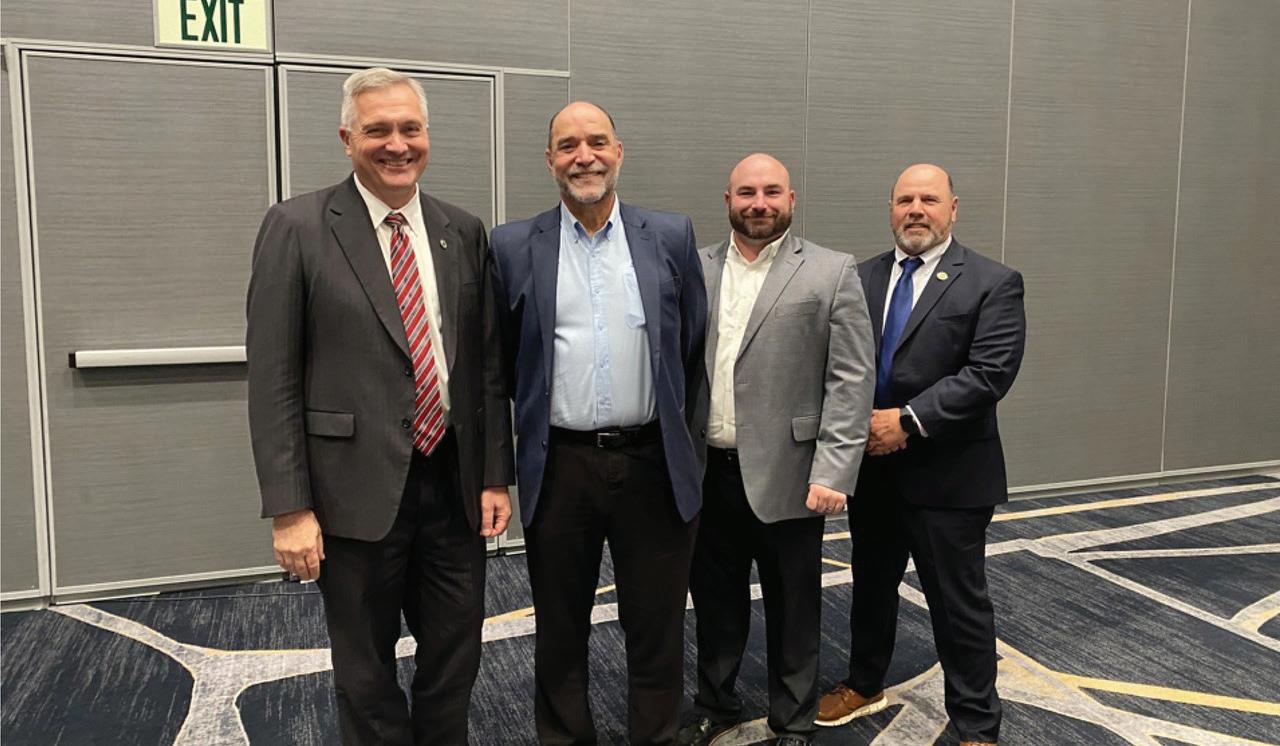

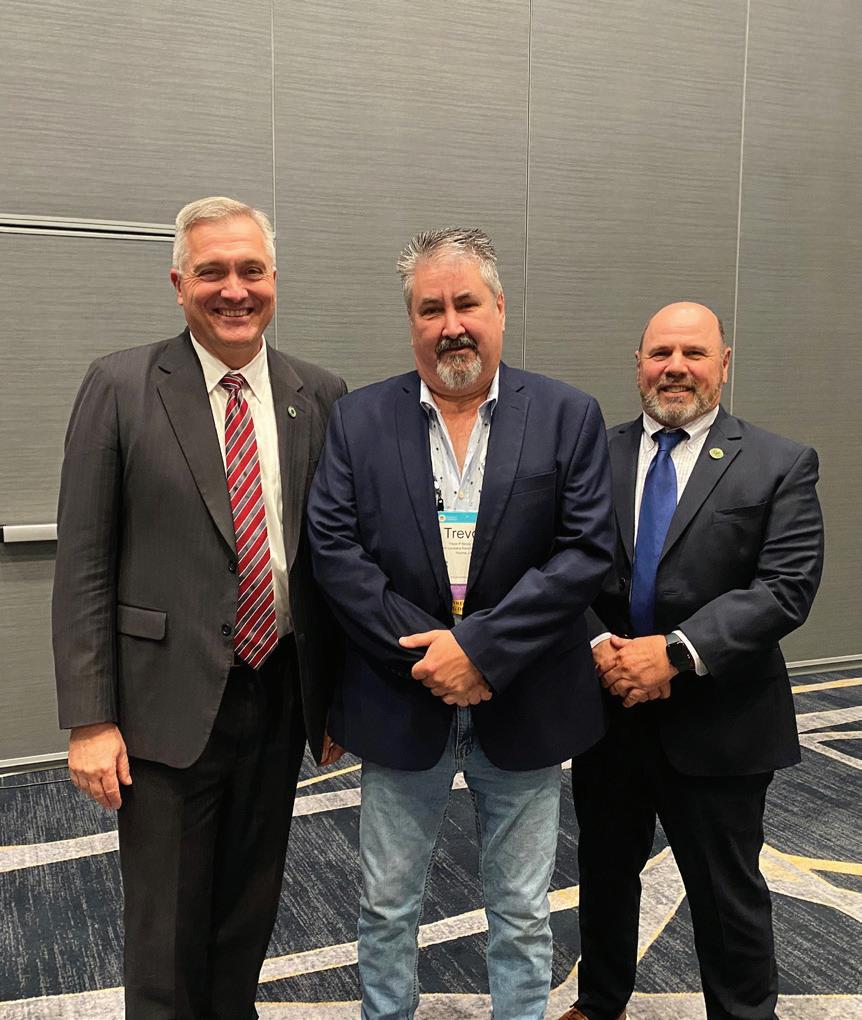
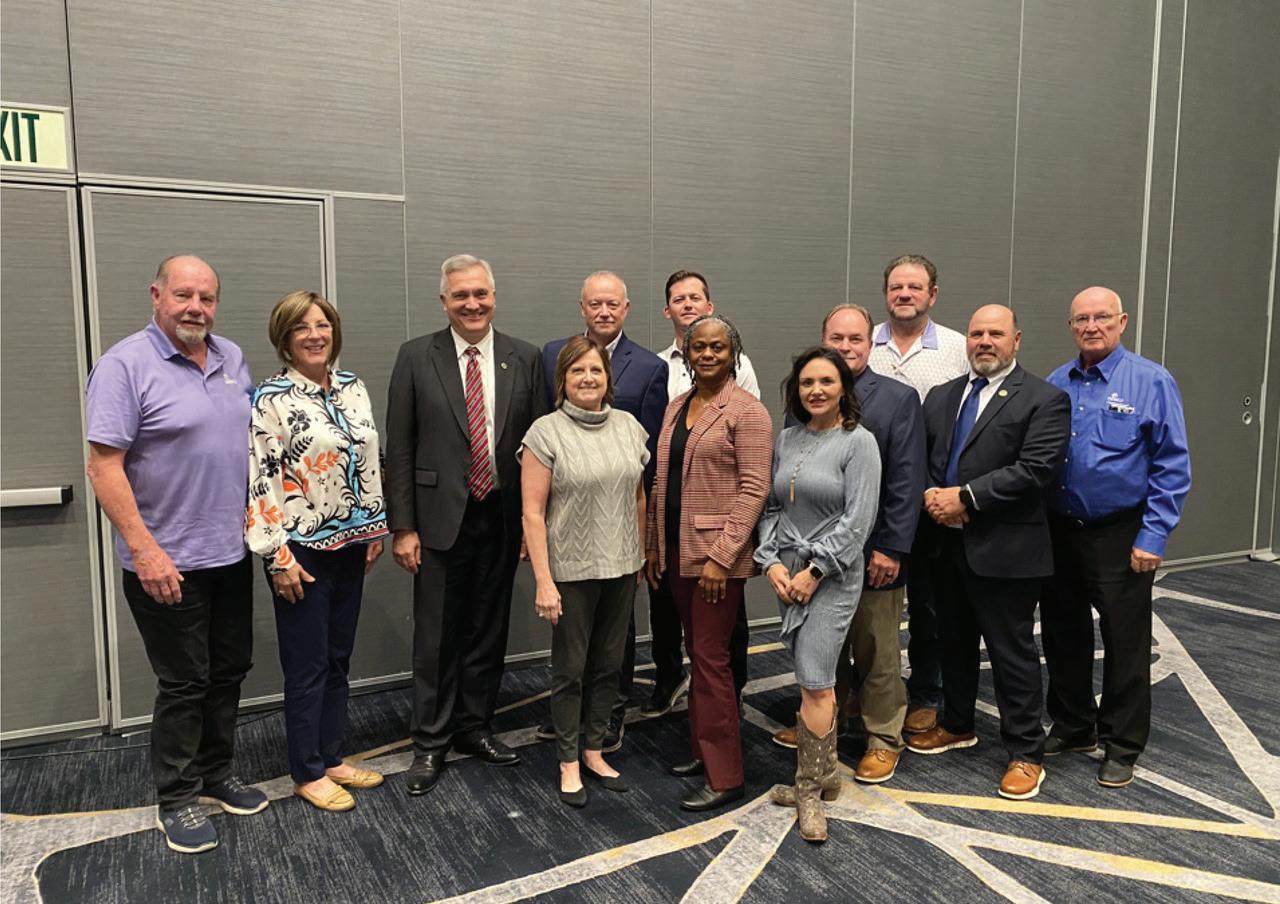
Two local juniors have the opportunity to take a weeklong, all-expenses-paid trip to Washington, D.C., sponsored by Washington-St. Tammany Electric Cooperative.
Parents or guardians of the students must be WSTE members. Students who want to have fun, meet students from across the country, speak to legislators, tour Washington, D.C., and become a part of a national fellowship can apply now. This trip is valued at more than $2,000.
About 25 young people throughout Louisiana join more than 1,800 students from 40 states June 14-21 for sightseeing and a chance to see how the government functions.
Before reaching Washington, D.C., students tour one of the Seven Wonders of the Modern World: the Natural Bridge in Shenandoah Valley, Virginia. In Washington, D.C., students tour the Lincoln and Jefferson memorials, Washington Monument, Vietnam and Korean memorials, Arlington National Cemetery, the Holocaust Museum, the Smithsonian Institution, Ford’s Theatre and the White House.
An entire day is spent touring the Capitol and visiting the offices of the Louisiana congressional delegation.
“This is a great opportunity to visit our nation’s capital,” says Coylean Schloegel, WSTE manager of marketing and economic development. “WSTE is dedicated to the education of our children through programs such as Youth Tour, our annual scholarship program and teacher mini grants.”
The contest is open to juniors of WSTE members. Students interested in applying must complete an application form and prepare a typed essay of up to 800 words on “How will AI (artificial intelligence) affect the electric cooperatives in the next five years?”
Submit your essay and application form by Feb. 25 to: WSTE, Attn: Coylean Schloegel, P.O. Box 697, Franklinton, LA 70438.
An independent board, selected by the Association of Louisiana Electric Cooperatives, judges the essays.









Return to: Washington-St. Tammany Electric Cooperative
Attn: Coylean Schloegel
P.O. Box 697
Franklinton, LA 70438
Name: ___________________________________________________
Age as of 1/1/2025: ________________________________________
Mailing Address: __________________________________________
Parent’s Name: ___________________________________________
Phone: __________________________________________________
Name on WSTE Account or Account No.: ________________________




































By John N. Felsher
This year, Louisiana opened a bear hunting season for the first time since the 1980s to trim the surplus of a growing bruin population. This hunting season demonstrates the success of a wildlife management effort going back decades.
American black bears once ranged across North America, from southern Florida to northern Alaska, and still occupy much of the continent. In 1907, President Theodore Roosevelt hunted black bears in northeastern Louisiana, where the Tensas River National Wildlife Refuge sits today.
Historically, Louisiana black bears, one of 16 subspecies, roamed the forests, swamps and canebrakes along the lower Mississippi River Valley and down the Atchafalaya River Basin. The Louisiana state mammal ranged into Mississippi, eastern Texas and Arkansas, possibly even parts of southern Alabama.
With overhunting and shrinking woodland habitat from clearcutting forests for wood products and agriculture in the late 19th and early 20th centuries, the Louisiana bear population plummeted. In 1992, the federal government declared the Louisiana black bear “threatened” and put all bears from southern Mississippi to eastern Texas under the protection of the Endangered Species Act. As the Louisiana bear population increased, the federal government “delisted” the species in 2016.
“We estimate probably more than 1,500 black bears live in Louisiana today,” says John Hanks, the Louisiana Department

of Wildlife and Fisheries Large Carnivore Program manager. “About 1,200 of them are in four monitored populations in the Tensas River Basin, the Richard K. Yancey Wildlife Management Area south of Ferriday, as well as the upper and lower Atchafalaya Basin areas.”
Although most Louisiana bears live in these four areas, bruins do roam around. Young male bears wander, looking to establish their own territories and find mates. Bears require considerable acreage. The home range of an adult male black bear might spread across 20,000 acres, with a breeding female living in about 5,000 acres.
“Bears might appear in any parish on any given day,” John says. “All monitored bear populations are stable and/or growing. We have excess animals, and we wanted to provide an opportunity for our sportsmen and sportswomen to utilize these animals.”
An increasing population of large, wide-ranging animals could put a strain on the available habitat. Therefore, the state allowed hunters to trim the bear population in parts of northeastern Louisiana with a limited hunting season, which lasted from Dec. 7-22.
Hunts took place in Bear Area 4, which includes all of East Carroll, Madison, Tensas and West Carroll parishes, as well as portions of Catahoula, Franklin and Richland parishes. Hunters could also hunt some wildlife management areas within that zone. Results of that hunt could not be obtained before press time.

ABOVE: An estimated 1,500 Louisiana black bears live in the Bayou State. Most of them are in northeastern Louisiana or the Atchafalaya Basin.
RIGHT: A female Louisiana black bear gives birth to one to three cubs every two to three years. The Louisiana bear population continues to grow.
PHOTOS COURTESY OF LOUISIANA DEPARTMENT OF WILDLIFE AND FISHERIES
Grizzly bears of the Rocky Mountains, Far West, Alaska and Canada typically weigh 600 to 800 pounds. Grizzlies can exceed 1,600 pounds and stand more than 10 feet tall. In comparison, their smaller black cousins in the eastern United States typically weigh about 100 to 350 pounds, although some can top 600 pounds. An average adult black bear stands about 21/2 to 3 feet high at the shoulder and can stand 4 to 7 feet tall on its hind legs.
“Male Louisiana black bears average approximately 325 pounds,” John says. “Females average approximately 200 pounds. The largest bear we have ever handled weighed 608 pounds. A 330-pound bear can provide about 200 plates of food for a family.”
Although much smaller than a grizzly, black bears still pose a threat to humans, especially a mother with cubs. Black bears rarely attack humans, but these incredibly powerful predators can inflict serious damage with their teeth and claws. Black bears can kill people and cause extensive property damage if they wish.
When a female black bear reaches about 2 years old, she starts to breed. Bears typically breed in July or August. The mother delivers one to three cubs in January or February every two to three years. She will likely live about 10 to 20 years and might produce 10 to 15 offspring in her lifetime.
Generally shy animals that avoid humans, black bears could live in an area without anyone knowing it or seeing it. In some areas, the large, curious creatures become so common they turn into pests that eat crops, destroy animal feeders, and raid garbage cans or pet foods left outside. If a bear really wants to get at something, it can rip it apart.

Hikers or others who encounter a bear in the wild should leave it alone and go elsewhere. Cubs might look like cute and cuddly fuzzballs, but Momma won’t be far away and she won’t look cuddly if someone messes with her babies. Get away from the cubs and out of that area.
“If a bear sees you, back away slowly,” John says. “Do not run. Running might trigger a chase response. If a bear approaches, stay together and hold your ground. Wave your arms and yell loudly. If the bear keeps approaching, use bear spray. If the bear makes contact with you, do not play dead. Fight back aggressively.”
Most human encounters with bears involve food. Many people put out corn to feed or attract deer. People fill bird feeders with seeds. Bears will find that corn or seed. Although bears eat meat if they can catch it, roughly 90% of a black bear’s diet consists of plant material, such as fruits, berries, grains and nuts. They also eat insects and practically anything else they can find or catch.
Don’t give bears any reason to come around a house. Never intentionally feed a bear or put out food to attract one. If bears start associating humans with food instead of danger, problems can occur. At night, bring in pets and pet food. Never leave any food or food residue where a bear can find it.
“The return of the black bear in Louisiana is a conservation success story and is a testament to the power of conservation and partnerships,” John says. “We are excited for the opportunity to give something back to the sportsmen and women of Louisiana.” n

By Trish Milburn
Life-changing. Perhaps that’s not a description most people would attach to a week of summer camp, but it’s exactly that for many of the Louisiana 4-H’ers who attend the annual Marsh Maneuvers program.
“Taking part in Marsh Maneuvers impacted what I wanted to do as a career,” says Branson Melancon, of Crowley.
A sophomore at Louisiana State University, he’s studying wildlife habitat conservation through LSU’s Natural Resource Ecology and Management program.
Marsh Maneuvers exposes high school students to the environmental, economic and cultural importance of Louisiana’s coast and the necessity of preserving it. The program started as a trip for 4-H students in Vermilion Parish in 1987, led by Mark Shirley, an aquaculture and marine specialist with the LSU AgCenter and Louisiana Sea Grant.
“Each summer, the 4-H junior leaders in Vermilion Parish would have a summer activity, such as going to Six Flags or the state capitol,” Mark says. “One year, there wasn’t enough money in the treasury.”
Because of the lack of funds for travel, Mark made arrangements for camping on Vermilion Bay. The attendees enjoyed it, went home and told their friends. The next year, neighboring Lafayette Parish wanted to take part as well. From there, the program snowballed.
Marsh Maneuvers quickly grew so popular it was expanded statewide, giving Mark help from other 4-H leaders and bringing about a more structured learning experience. Since 1989, close to 2,000 4-H students have taken part in one of the four weekly camps held each July—with the exception of a few years because of the COVID-19 pandemic and hurricanes.
“Youth are engaged in the learning process on all levels: listening to speakers, seeing things firsthand and actually doing






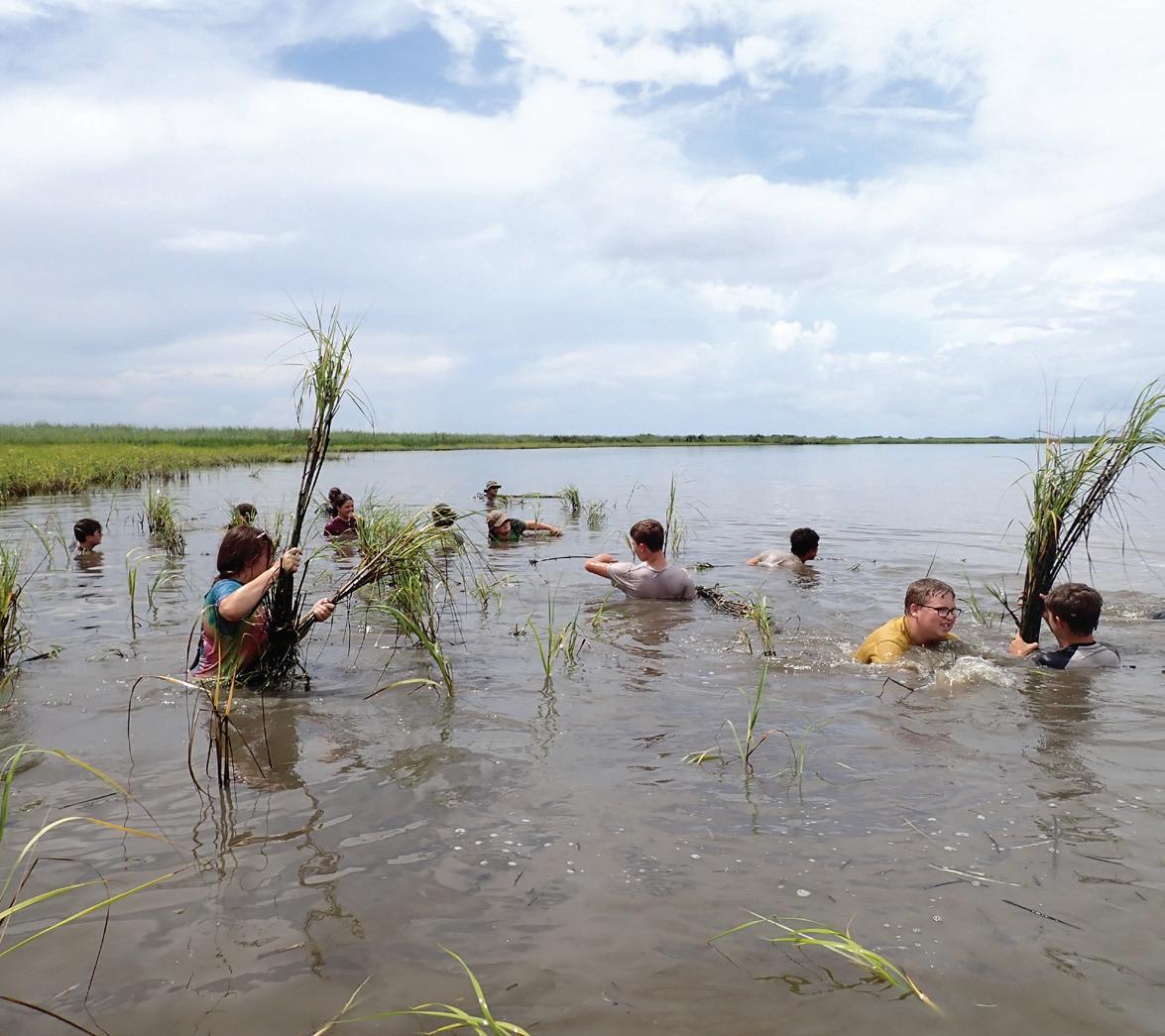





related hands-on activities—harvesting and boiling crabs, catching and cleaning fish, casting nets to catch shrimp and learning how to locate alligators after dark,” Mark says. “This experiential learning process helps youth retain this knowledge long term.”
Mark knows this because some of those campers from the early years have told him so and now send their children to Marsh Maneuvers.
Catherine Fox, assistant specialist for the Youth Wetlands Program at the LSU AgCenter and co-director of Marsh Maneuvers, says the weeklong camps are action-packed. The activities and learning opportunities attract students from all over the state, even those without experience with Louisiana’s quintessential marshes. Such was the case for Isabel Dean from Bossier City.
“I got an email about the camp and thought it sounded super intriguing,” Isabel says. “The camp ended up being the defining point of my life.”
Isabel entered Marsh Maneuvers curious and left with a direction and mission. She’s now a junior in LSU’s College of the Coast and Environment and wants a hands-on environmental career where she can see an immediate difference.
Isabel liked taking part in the summer session so much she returned for Advanced Marsh Maneuvers in the winter, what she calls Marsh Maneuvers 2.0. The winter program focuses on freshwater marshes, while the summer camps focus on the brackish and saltwater marshes along the coast.
The winter camp, held at White Lake Wetlands Conservation Area south of Gueydan, also teaches campers about conservation efforts and waterfowl management. This site provides wintering grounds for lots of waterfowl and is where the whooping crane was reintroduced to Louisiana in 2011 after being missing from the state for six decades.
While the summer camps feature marsh volleyball as a fun activity, the winter camps offer the Amazing Marsh Race, a fourhour scavenger hunt. Campers acquire clues through challenges, such as correctly identifying different duck species and building wood duck nesting boxes.
Marsh Maneuvers has seen some necessary changes over the years—everything from how participants are chosen to location. Early on, the camps were held at a research lab for marine and coastal research run by the University of Southwestern Louisiana—now University of Louisiana at Lafayette. Later, it moved to a Louisiana Department of Wildlife and Fisheries marine lab on Grand Terre Island. This move proved to be a logistical challenge because everything and everyone that made the camp run had to be transported there by boat.
During a large portion of the program’s history, campers have stayed and taken part in programs at Rockefeller Wildlife Refuge, marshland that borders the Gulf of Mexico in Cameron and Vermilion parishes and one of the most biodiverse wildlife areas in the United States. Following damage caused by Hurricane Delta in 2020, however, participants moved to a bunkhouse in Intracoastal City while repairs are made at the refuge.
Hurricanes are a fact of life along the coast, and learning about them and their impact is part of the camp curriculum.
“Louisiana has dealt with hurricanes for hundreds of years, and we’re still not going to abandon the coast,” Mark says. “It’s worth the risk to be as resilient as possible and to build back better, including learning how to build homes that can withstand the storms—higher to avoid the water and stronger to avoid being blown away.”
Marsh Maneuvers sponsors contribute not only money for the camps, but they also provide knowledge and resources.
The Louisiana Coastal Protection and Restoration Authority provides the grant that helps fund Marsh Maneuvers and Catherine’s position. The Louisiana Department of Wildlife and Fisheries, which operates the Rockefeller and White Lake sites, has provided airboats and drivers to take students out into the marsh, where they plant smooth cordgrass that provides food and habitat for a variety of marsh-dwelling species. Campers learn about the jobs available through Wildlife and Fisheries, including those at the refuge.
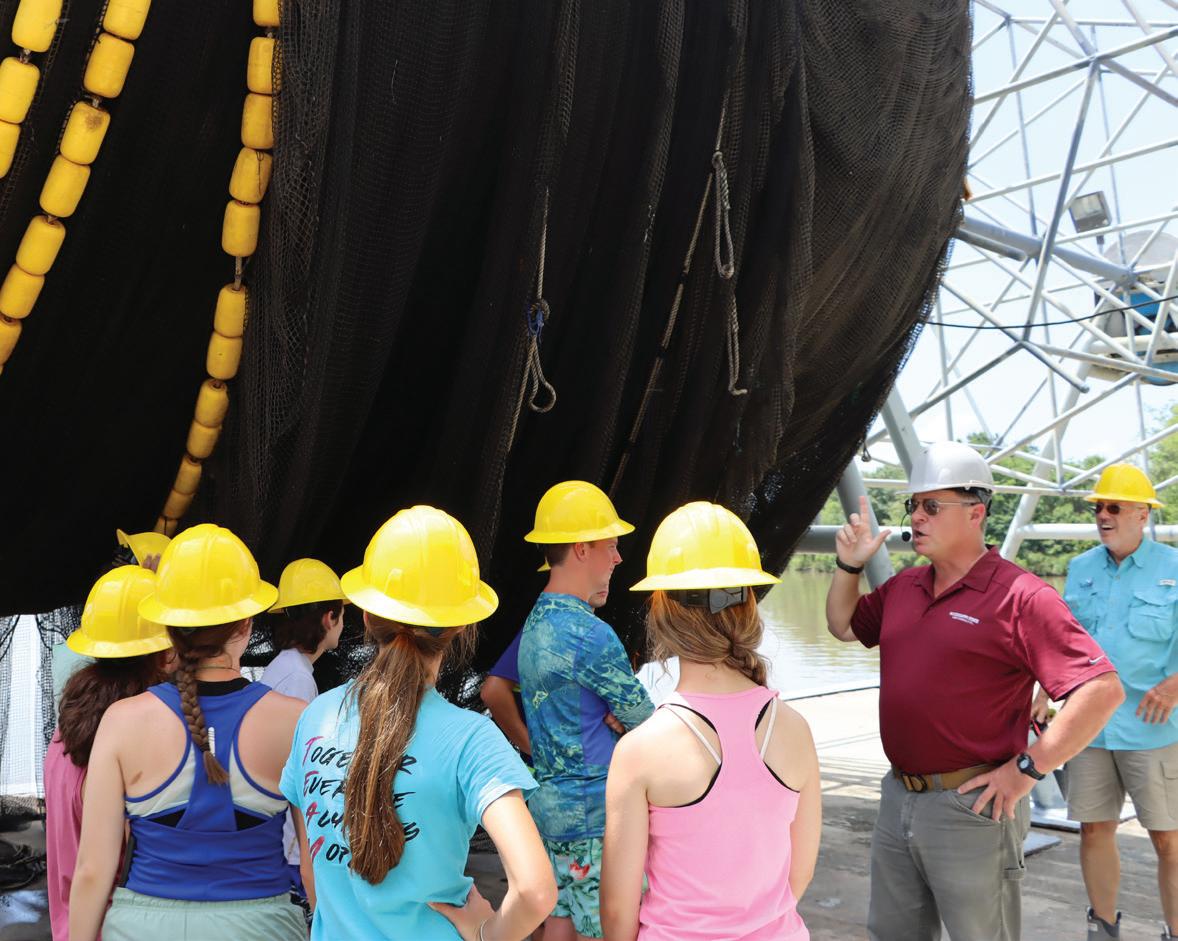

Corporate sponsorship is important to the success of the camps. McIlhenny Co., makers of Tabasco, provides an airboat and driver to Avery Island, where the famous pepper sauce is made. Students have lunch at a trappers’ camp and learn about the history of the fur trapping industry in Louisiana as well as how people depended on it for their livelihoods.
SHUCKS! Seafood Restaurant in Abbeville provides dinner and opportunities for learning. Students are brought to the shucking room to learn about the oyster industry and food safety. Gulf South Seafood provides shrimp for dinner at each of the weekly camps. Staff members share their knowledge of the shrimping industry, and students peel and cook the provided shrimp.
Catherine says the relocation to Intracoastal City created new opportunities for campers. They were able to tour Omega Protein’s menhaden processing plant; visit the Coast Guard Cutter Amberjack, where they talked to active-duty members of the U.S. Coast Guard about their jobs; and went on a canoe float trip.
“Marsh Maneuvers is really good at showcasing careers,” says McKaila Darden Stafford, who took part in the camp as a student and later returned as an intern while in college. “It really has an impact.”
McKaila, who grew up on the Chitamacha Tribe of Louisiana’s Reservation in Charenton, says Marsh Maneuvers helped solidify her interest in the environment into a career path. She attended college at LSU and works as a wetland scientist for the Louisiana Department of Transportation, reviewing projects for potential wetland impacts.
In addition to all the learning and hands-on activities that fill the campers’ days, there’s also time to simply admire the natural beauty of the area.
“Louisiana’s environment is unique,” McKaila says. “I loved camping at the Rockefeller Wildlife Refuge, seeing the alligators and birds, some of which are only seen in the marsh. And the sunsets are so pretty out there.”
Even though Branson grew up going to Rockefeller to fish and crab, during his Marsh Maneuvers experience he got to see behind the scenes of how the refuge is run and what it takes to protect it.
“It was an amazing experience and impacted what I wanted to do as a career,” he says. “It’s why I come back and volunteer with Marsh Maneuvers. I hope to help other people find what they are looking for.”
“Marsh Maneuvers is the most demanding part of my job, but I look forward to it each year,” Catherine says. “It’s satisfying to see campers who come in a bit unsure about what the week will hold become fully invested and wanting to learn more, not ready for the week to end.”
Mark says even if Marsh Maneuvers campers don’t go into environmental fields for their careers, the knowledge they gain at the camps can still help them and Louisiana as a whole. Students who went on to become teachers have told him they use what they learned at Marsh Maneuvers in their classrooms.
With more than 35 years devoting time and effort to Marsh Maneuvers, Mark says he has enjoyed working with all the young people who have attended the camps.
“I like seeing their enthusiasm when you teach them, for instance, how to cast a net and catch shrimp. It’s as much fun for me as it is them. It will be an indelible memory in their minds for the rest of their lives.”
Information on how to apply to attend the 2025 Marsh Maneuvers Program is available early in the year. Visit tinyurl.com/MarshManeuvers.



If you love music,Mi i
American music is a truly global phenomenon, but its roots trace back to one place—Mississippi. Over 100 years ago, in the Mississippi Delta, the blues ignited a music revolution that would give rise to rock ‘n’ roll, gospel, country, and R&B while influencing genres from jazz to hip hop. And the story continues today. In Mississippi, you can explore the lives and legacies of icons like B.B. King, Elvis Presley, and Muddy Waters at music museums and on the Blues and Country Music Trails, or catch today’s rising stars at juke joints, music clubs, and theaters across the state. Learn more at VisitMississippi.org/Music.











Listen to the “Birthplace of America’s Music” playlist on Spotify.





Washington-St Tammany Electric Cooperative Inc.
“WST Electric is an equal opportunity provider and employer”
The Annual Membership Meeting of Washington-St. Tammany Electric Cooperative, Inc. will be at 10 a.m. Saturday, May 3, 2025, at the Franklinton High School in Franklinton, Louisiana.
The purpose of the meeting is to conduct the business of the membership and elect three (3) members to the Board of Directors. Election of members to the Board of Directors will be held by mail ballot.
One-third (1/3) of the Washington-St. Tammany Cooperative, Inc. Board of Directors (3 Directors) shall be elected to a three (3)-year term on Saturday, May 3, 2025. Two (2) of the directors to be elected shall be residents of Washington Parish and one (1) of the directors to be elected shall be a resident of Tangipahoa Parish.
Any incumbent director may be a nominee by filing a letter of intent with the Cooperative by 4 p.m. Thursday, March 13, 2025, at which time nomination of such directorship is to be closed. Any other member of the Cooperative may be nominated by filing a petition, which can be picked up from the Administrative Assistant in Franklinton, at 950 Pearl St., between the hours of 7:30 a.m. and 4 p.m. Petitions must be returned to the Cooperative office by 4 p.m. Thursday, March 13, 2025, containing the signatures of 15 or more members in good standing of the Cooperative as of that date.
SHALL BE CLOSED AT 4 P.M.
THURSDAY, MARCH 13, 2025

















By Scott Flood


Starting the new year off with a plan for new appliances? Retailers are trumpeting deep discounts on home appliances as they clear out last year’s inventory. That’s great if you’ve considered replacing some of your home’s tired appliances with one of today’s smart models. But before buying a smart appliance, take some time to learn what they offer—and think about what you really need.

Begin with an honest look at how you live, and consider the role your current appliances play in your daily routine. Would the capabilities of a smart appliance make your life easier? For example, if you frequently forget to start the laundry or your dishwasher, Wi-Fi-enabled appliances with remote start capabilities may save you time and trouble.

If you’re thinking about stepping up to a smart appliance because it has a cool feature you might use once a year, ask yourself if it’s worth the extra cost.
Next, think about any smart devices you already use in your home. Make sure they’re compatible with the smart appliance’s operating system, so you can get all the benefits you expect. For example, many of these appliances are engineered to work with familiar voice assistants, such as Amazon Alexa, Google Assistant or Apple’s Siri. Incompatible systems might limit your ability to use the features most important to you.


Is your home’s infrastructure ready to handle the demands of a smart appliance? Depending on the model you choose, it might require anything from a basic internet connection to a home Wi-Fi network to provide the operation you expect.
Some smart appliances may require Bluetooth, Zigbee, Z-Wave or other systems for connectivity. Others can receive software updates via Wi-Fi. Having





access to the right technology ensures your system functions correctly and can handle updates as they become available.
It’s always important to consider energy efficiency when buying a new appliance. Most smart appliances are designed to reduce energy consumption, with operating modes that deliver the performance you want while making more efficient use of energy.


Smart appliances that are Energy Starcertified meet or exceed federal energyefficiency standards, and some may use only half as much energy as standard appliances. Many let you schedule operations during times of the day when energy rates are lower. That’s particularly beneficial with high-energy appliances, including washing machines, dishwashers and clothes dryers.
Repairs to smart appliances can be expensive, so be sure to consider










the warranty. Generous manufacturer warranties demonstrate the company’s confidence in the quality of its products.
Finally, because most smart appliances are connected to the internet, make sure you think about privacy and security. Research the manufacturer’s privacy policies and security features to ensure data —like your voice commands and shopping habits—don’t fall into the wrong hands. Making sure the manufacturer takes your privacy and online safety as seriously as you do is a smart strategy.

For most homeowners, the biggest downside to smart appliances is they carry higher price tags than their not-so-smart counterparts. However, price is just one factor in the cost of any appliance. When you also consider the long-term value smart appliances deliver—whether that’s in energy savings, helpful conveniences or improved reliability—most save you money over their service life.

Smart appliances may be eligible for rebates and tax incentives, so ask your retailer what’s available.
What’s ahead for smart appliances in the foreseeable future? The marketplace is starting to see the integration of basic artificial intelligence capabilities that can make smart appliances provide better service, greater reliability and lower energy needs. As these AI-fueled systems become more common, your refrigerator might know your habits so well it can generate a shopping list for you. Your dishwasher could adjust its operating cycle to better clean your family’s uniquely dirty dishes.


There was a time when appliances changed little from decade to decade. Today, products advance more quickly than ever before, and we can expect to see more big changes ahead.


By Jennah Denney
Looking for ways to better manage your energy use? One of the best ways to make your home more energy efficient is by choosing products with the Energy Star label. But what exactly does the label mean, and how can it benefit you?
Energy Star is a program by the U.S. Department of Energy and the Environmental Protection Agency to help consumers identify energyefficient products that save money and reduce environmental impact.
Products that earn the Energy Star label must meet strict guidelines for energy efficiency, performance and cost effectiveness. Here’s how the process works:
The product must be more energy efficient than typical models. This helps you save on energy bills by using less electricity while still providing the same performance.
The product must be tested in EPA-recognized labs following standardized procedures. These tests ensure the product meets all energyefficiency and performance requirements.
Once tested, the product’s data is reviewed by a third-party certification body to verify it meets the set standards. This ensures only the best products receive the Energy Star label.
Even after a product is certified, the EPA conducts off-the-shelf testing on random samples of Energy Star products to ensure they continue to meet the required standards. If a product fails to meet the performance requirements during verification testing, it can be disqualified from the Energy Star program. The EPA has clear procedures for handling such disqualifications to maintain the integrity of the label.
Whether you’re upgrading your refrigerator, replacing lightbulbs or buying new electronics, the blue Energy Star label is your assurance the product has passed all energy-efficiency tests. It’s easy to spot and can be found on products ranging from small and major appliances to electronics.
Many large appliances, such as washing machines and clothes dryers, include a yellow Energy Guide label that provides estimated energy use. Comparing these labels can help you determine how much you can save with an Energy Star model compared to a standard model.
While Energy Star products can cost a little more upfront, their energy savings over time often cover the difference. They help reduce your household energy consumption, which could translate to lower utility bills.
As you shop for appliances, electronics or other home equipment, look for the Energy Star label. Whether it’s a new washing machine or energyefficient lighting options, these products are a simple and effective way to save money and lower energy use. Check with your electric utility about rebates or incentives for buying Energy Star products.
To browse products that have earned the Energy Star® label, visit www.energystar.gov.

Washington-St. Tammany Electric
Cooperative lineworker Jeff Landor works on a rescue during pole-top training.
OPPOSITE PAGE: Ricky Melancon, ALEC safety and training coordinator, and WSTE Safety Coordinator Chad Angelo watch as Lane Starkey, on pole, and Tyler Bunn, in bucket, complete a rescue during training. PHOTOS COURTESY OF WSTE


By Chad Angelo, WSTE Safety Coordinator
Washington St.-Tammany Electric Cooperative is committed to providing reliable power through our power grid. However, another priority is ensuring this service is delivered safely, not only for our employees but also for the public.
Lineworkers, along with other employees, undergo rigorous training throughout the year. A training and safety meeting takes place once a month in the northern and southern districts. Additionally, when time permits, multiple safety meetings and training sessions are conducted monthly.
In addition to monthly training, lineworkers and substation technicians benefit from participating in the Northwest Lineman College four-year correspondence course, which enhances their skills.
Meter technicians gain knowledge by attending classes throughout the state, ensuring they stay updated with the latest industry practices. WSTE takes advantage of multiple training opportunities throughout the year including schools and training courses sponsored by the Louisiana Superintendents and Foremen’s Association as well as monthly training opportunities provided by the Association of Louisiana Electric Cooperatives.
ALEC also facilitates the Northwest Lineman College training program. This program requires lineworkers to spend more than 150 hours in the classroom alongside on the job training.
The training is preparation for major incidents—emergencies to storm damage. By building necessary skills, strength and education employees are prepared to excel when it matters most. Essentially, they are equipping themselves to manage high-pressure situations with the best possible outcomes.
Some of the training topics conducted throughout the year include etering, Right of Way, Apprentice Program, National Electric Safety Code, National Electric Code, Occupational Safety and Health Administration, Live-Line Equipment and
CPR, AED, First Aid, Rigging, Bucket Truck Rescue, Pole-Top Rescue, and Federal Motor Carrier Safety Regulations.
One of the key topics we discuss is poletop rescue. This training is unique. While first responders have their own critical skills, pole-top rescue is a unique expertise only lineworkers possess. This training is essential for qualified employees and is mandated by OSHA standards. To maintain their qualifications, lineworkers must be taught and demonstrate proficiency in poletop rescue at least once a year.
The Steps to Pole-Top Rescue
Imagine a four-person crew, whether working on new construction or emergency restoration jobs. The process begins with a job briefing, where every crew member understands the task through clear communication and documentation of the job briefing/job safety analysis or tailgate session. Once the job starts, the crew member ascending the pole carries the proper personal protective equipment and tools needed to complete the task.
Then, an accident happens—an unexpected event resulting in injury, damage or loss. This is where the training kicks in. The primary focus is on getting the injured employee to the ground safely. Other crew members initiate emergency procedures, such as making a mayday call on the radio or calling 911, and ensuring the utility line is deenergized and safe for rescue operations.
A second lineworker then ascends the pole, assesses the injured employee and begins rigging a rope (handline/lifeline) to lower the employee to the ground. Once on the ground, CPR and/or first aid can be administered until emergency services arrive.
Sound intense? From the moment of the accident, the lineworker has only four minutes to get the injured colleague to the ground and start CPR or first aid.
Why the rush? Brain cells begin to die after four minutes without circulating blood carrying oxygen to the brain. For every minute lost, there is a 10% chance of brain damage or loss of life. After 10 minutes, brain

damage is irreversible, or it results in death.
This tight time limit means every second counts, and the worker must act swiftly to get their tools, ascend the pole, rig the injured worker and perform CPR.
A lineworker’s career is a distinguished one. Is it hard? Absolutely. You must be physically strong, mentally sharp and willing to endure uncomfortable situations for prolonged periods. Whether you are facing 20 mph winds, snow and sleet at 20 degrees, or a hurricane with 60 mph winds, 90% humidity and 100-degree heat, you must be ready.
This job often requires getting up in the middle of the night, venturing out in lightning storms, and navigating the dangers of downed trees and power lines in the dark.
Despite the challenges, the job is rewarding and takes a special kind of person. The next time your lights go out and you are cozy in bed, remember that lineworkers are out there in dangerous conditions, working tirelessly to restore power as quickly and safely as possible so they can return home to their families.
Our employees are members of your community. We live in the same neighborhoods, shop at the same stores, and our children attend the same schools and churches. If your lights are out, there is a good chance our employees’ lights are out, too.
We are always committed to serving our members and communities by providing safe and reliable electricity—24 hours a day, seven days a week and 365 days a year. n
These days, nearly everyone is looking for ways to save money and use energy more efficiently. As we start the new year, work to decrease your energy footprint. Simple changes can make a big difference over the life of a home—and there is no better time to take steps toward a healthier utility bill and a cleaner environment.
1. Unplug items from the wall, and turn off power strips. Many devices use electricity even when turned off, including TVs, printers, chargers, copiers, coffee makers, microwaves and lamps.
2. Switch off lights when leaving the room. It’s an easy way for every member of your household to contribute to energy savings.
3. Plug electronics into a smart power strip. Replace standard power strips with advanced power strips. Smart power strips can detect when a device is in standby mode and cut power off to save energy. A standard power strip must be physically turned off when not in use.
4. Use a programmable thermostat. Set your thermostat at a comfortable temperature, but program it to lower the temperature when you are away from home or sleeping and raise it when you’re there and awake to save on heating and cooling costs.
5. Use dimmer switches. Dimmer switches reduce the flow of electricity, saving you energy and money.
6. Lower your water heater temperature. For safety and efficiency, set your water heater thermostat to 120 F.
7. Weatherstrip exterior doors and windows. Sealing air leaks around doors and windows saves energy and can reduce heating and cooling costs by 10% to 30%.
8. Check the settings on your refrigerator. The fridge should be between 38 and 42 degrees Fahrenheit, and the freezer should be between 0 and 5 degrees. Check the seals for cracks and dried-on food. Keep the condenser coils underneath the fridge clean.
9. Turn off the heat dry on your dishwasher. Allow dishes to air dry to save energy and money on your electricity bill.
10. Use ceiling fans, but only when you are in the room. Fans cool people, not rooms, by creating a windchill effect. If the room is unoccupied, turn off the ceiling fan to save energy.
11. Keep your refrigerator and freezer stocked. A full fridge and freezer cuts electricity use by acting as insulation.





12. Use LED lighting. Residential LEDs use at least 75% less energy and last 25 times longer than incandescent lighting.
13. Wash laundry in cold water. Today’s washing machines are designed to work efficiently with cold water. You can save up to $60 a year by selecting the cold water setting when you wash.
14. Upgrade outdated appliances with Energy Star appliances. Look for newer, more energy-efficient models. The energy savings and tax rebates available are worth the initial cost.
15. Use wool or rubber dryer balls. This helps reduce drying time and cuts down on static. Wool dryer balls also absorb extra moisture and are an alternative to dryer sheets.
16. Keep your computer in sleep mode. You may be done using it, but if it’s not set on sleep mode, the computer still uses electricity.































